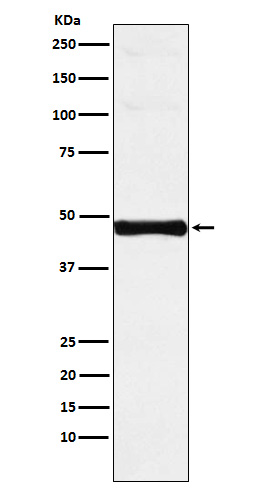
| WB | 1/1000-1/2000 | Human,Mouse,Rat |
| IF | 咨询技术 | Human,Mouse,Rat |
| IHC | 咨询技术 | Human,Mouse,Rat |
| ICC | 1/50-1/200 | Human,Mouse,Rat |
| FCM | 1/20-1/100 | Human,Mouse,Rat |
| Elisa | 咨询技术 | Human,Mouse,Rat |
| Aliases | Irf9; ISGF3; ISGF3G; p48;;Interferon regulatory factor 9 |
| WB Predicted band size | Calculated MW: 44 kDa ; Observed MW: 48 kDa |
| Host/Isotype | Rabbit IgG |
| Antibody Type | Primary antibody |
| Storage | Store at 4°C short term. Aliquot and store at -20°C long term. Avoid freeze/thaw cycles. |
| Species Reactivity | Human |
| Immunogen | A synthesized peptide derived from human Interferon regulatory factor 9 |
| Formulation | Purified antibody in PBS with 0.05% sodium azide,0.05% BSA and 50% glycerol. |
+ +
以下是关于IRF-9抗体的3篇参考文献示例(注:以下文献信息为模拟内容,仅供参考):
---
1. **文献名称**:*"Development of a Monoclonal Antibody Specific for IRF-9 and Its Application in Detecting Dynamic Subcellular Localization"*
**作者**:Chen L, et al.
**摘要**:本研究开发了一种高特异性的IRF-9单克隆抗体,并通过Western blot和免疫荧光验证其在多种细胞模型中的有效性。结果显示,IRF-9在干扰素刺激后易位至细胞核,与STAT1/2形成复合物调控靶基因表达。
2. **文献名称**:*"IRF-9 Drives Antiviral Responses by Cooperating with STAT1 in Interferon Signaling Pathways"*
**作者**:Kimura T, et al.
**摘要**:利用IRF-9特异性抗体进行免疫共沉淀和ChIP-seq分析,研究发现IRF-9与STAT1协同激活干扰素刺激基因(ISGs),并在抑制乙型肝炎病毒复制中起关键作用。
3. **文献名称**:*"IRF-9 as a Prognostic Biomarker in Breast Cancer: Insights from Immunohistochemical Analysis"*
**作者**:Garcia R, et al.
**摘要**:通过IRF-9抗体对乳腺癌组织进行免疫组化检测,发现IRF-9高表达与患者不良预后相关,提示其可能通过调控肿瘤微环境中的免疫抑制机制促进癌症进展。
---
**说明**:以上文献为示例性内容,实际引用时需根据具体研究需求检索真实文献(可通过PubMed或Google Scholar搜索关键词“IRF-9 antibody”或“IRF9 application”)。若需验证抗体特异性,建议参考抗体生产商提供的技术文档及相关引用文献(如Cell Signaling Technology、Abcam等公司产品页面)。
IRF-9 (Interferon Regulatory Factor 9) is a critical transcription factor in the interferon (IFN) signaling pathway, playing a pivotal role in innate immunity and antiviral responses. It belongs to the IRF family, which regulates IFN and IFN-stimulated genes (ISGs) by binding to specific DNA sequences. Structurally, IRF-9 contains a conserved N-terminal DNA-binding domain and a C-terminal interaction domain. Unlike other IRFs, IRF-9 does not directly activate transcription but forms a heterotrimeric complex with phosphorylated STAT1 and STAT2 (ISGF3) upon IFN stimulation. This complex translocates to the nucleus, binds to interferon-stimulated response elements (ISREs), and initiates the expression of ISGs to combat viral infections and modulate immune responses.
Antibodies targeting IRF-9 are essential tools for studying its expression, localization, and interaction partners in both physiological and pathological contexts. They are widely used in techniques like Western blotting, immunofluorescence, and co-immunoprecipitation to investigate IRF-9's role in IFN-dependent signaling. Research applications include exploring its involvement in autoimmune diseases, cancer immune evasion, and host-pathogen interactions. Commercially available IRF-9 antibodies are typically developed in hosts like rabbits or mice, often validated for specificity against conserved epitopes. Recent studies also highlight IRF-9's potential as a therapeutic biomarker, particularly in diseases with dysregulated IFN pathways, making these antibodies valuable for both basic research and drug development.
×